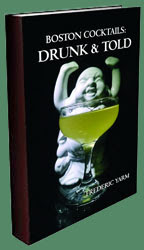I will complete my fifth annual trilogy of year end wrap up posts by picking out the best recipes we tried at our home bar this year. I used to also tack on the best of my own creations at the end of the post, but I think I covered that in the first part of the trilogy. Thus, this list is dedicated to the best recipes created by bartenders, living, deceased, and unknown, from around the world all brought to me at my home bar (where pants are optional).
January: The top two drinks of the month were Dee Allen's
Bitter Stripper, a White Negroni variation from Gaz Regan's
Negroni book, and Brian Summers'
Chicago Typewriter, a Genever and rye tribute to the Thompson submachine gun that I spotted on the Bols Bartending Facebook page.
February: The month's nod goes to a drink that pre-dated the name for the Vodka Martini also known as the Kangaroo. This
Kangaroo from
Pioneers of Mixing at Elite Bars: 1903-1933 is like a gussied up Puritan. For runner up, Erik Carlson's
Primrose Hill (pictured below) that I spotted in
Imbibe Magazine was a solid Martini variation that had aspects of the Martinez and Hanky Panky playing out (with dry vermouth instead of sweet though).
 March:
March: My mind returns to the
West Indies Punch that I found in Trader Vic's
Book of Food & Drink; guava paste brought out aspects of Jerry Thomas' Barbados Punch, and green tea and Madeira did no harm here either. For second nod, the sherry Negroni riff the
Haberdasher from Josh Harris and Scott Baird as appears in
The Art of the Shim book. Also for second nod, the quirky and intense
Louis Special from 1940's
The How and When equal parts the gin, Chartreuse, and Benedictine in a very modern style.
April: The hands down recipe for April is Meaghan Montagano's
Persephone that I spotted on the
ShakeStir website; it possessed a sparkling Seelbach-Lucien Gaudin sort of magic.
May: I went classic with my top choice of the month with the
Fedora that sporadically gets ordered at work. Since I have never made one of these Sidecars with the brandy split with Jamaican rum and Bourbon for the blog, I went ahead and merged recipes from Harry Johnson's 1882
New and Improved Bartender's Manual and Stan Jones'
Complete Barguide. Runner up was a sadly unattributed recipe from
75th Anniversary Edition of Mr. Boston called
Count Camillo's Paloma (pictured below) -- yes, a tequila Negroni lightened with grapefruit soda!
 June:
June: A tough two to pick a winner, but the
Bone Machine from Jeff Lyon via
Liquor.com made for an elegant Manhattan variation with sherry and a pair of herbal liqueurs as accents. For a runner up in this tight race,
Doff Your Hat from David Willhite via
75th Anniversary Edition of Mr. Boston combines genever, Cynar, and Grand Marnier rather well.
July: The nod for July goes to the Seelbach variation,
Handbook for the Recently Deceased, created by Timothy Miner that I spotted on the
OnTheBar app; the drink's name and movie allusion does not hurt its standing either. For second tier awards, Roman Milotivy's
Visionary Cocktail from
World's Best Cocktails was rather good with my gin-for-vodka substitution, but it might have taken the lead for July with a dark rum sub instead.
August: Another tough month to narrow winners down, but in the end the
Lizard King from Carlos Garcia and CM Almeida via the
OnTheBar app had alluring funky notes in Tiki format. For runners up, there was the more classic feeling
Autumn Leaves, a Jeffrey Morgenthaler recipe I spotted in the
75th Anniversary Edition of Mr. Boston , and the modern eccentric riff
Haji Sling (pictured below), Ian Loh's Angostura-heavy Singapore Sling variation from Gary Regan's
101 Best New Cocktails.
 September:
September: Two Tiki recipes got my attention this month. The winner was
The Valdez from Parker Girard via the
OnTheBar app that he describes as a cross between a Daiquiri, Jungle Bird, and Corn and Oil. Second nod goes to a classic Tiki from Beachbum Berry's
Potions of the Caribbean, namely Joe Scialom's
Sol y Sombra from 1957.
October: For top dog of October, I picked Amanda Elder's
Midnight Matinee from this year's Vinos de Jerez Cocktail Competition due to its elegance and flavor complexity. For runners up, there was Eryn Reece's
Broken Oath from the
Death & Co. Cocktail Book with more sherry love -- this time with mezcal and espresso liqueur. And there was the
Kentucky Island (pictured below), a Bourbon tiki number from
Sanctuaria, the Dive Bar of Cocktail Bars book.
 November:
November: A quirky drink from
Pioneers of Mixing at Elite Bars: 1903-1933 called the
Chauncy Depew caught my attention; the best way to describe it is a sherry Japanese! With the right nutty sherry-orgeat pairing, the idea is more solid than the Japanese Cocktail itself. The runner up for November stuck with the fortified wine idea with the
Vermouth Cocktail from The Only William's 1891
The Flowing Bowl.
December: Tied for drink of the month are Erick Castro's hot toddy Boulevardier riff, the
Babbo's Toddy via his Instagram, and Leo Robitschek's agave-sherry drink, the
Repossession via Talia Baiocchi's
Sherry book. For a secondary nod approval, I picked Theo Lieberman's
Third Bird via the Amaro Montenegro Facebook page; this Tiki libation riffed on the Jungle Bird but added cacao and utilized a less bitter amaro in the mix.







 The theme for this month's
The theme for this month's 




















 The 2017 collection of 855 drink recipes, bartender tributes, and essays on hospitality from CocktailVirgin's Frederic Yarm. Available at
The 2017 collection of 855 drink recipes, bartender tributes, and essays on hospitality from CocktailVirgin's Frederic Yarm. Available at  The 2012 collection of 505 drink recipes, techniques, and Boston bar recommendations from Frederic Yarm. Available at
The 2012 collection of 505 drink recipes, techniques, and Boston bar recommendations from Frederic Yarm. Available at 



